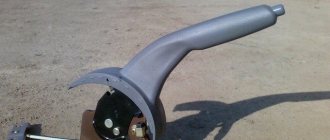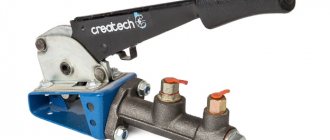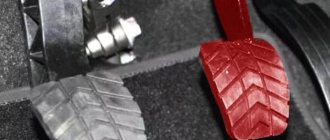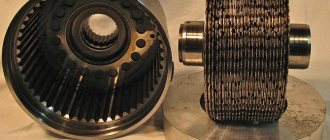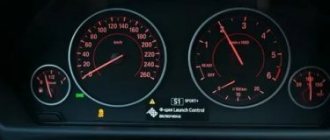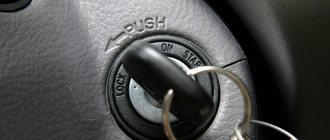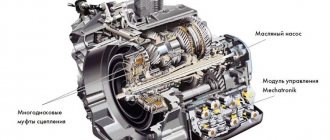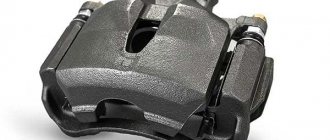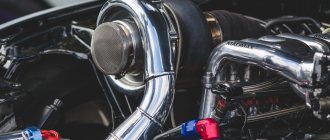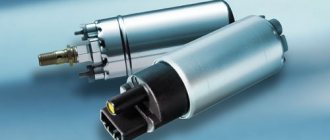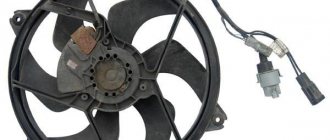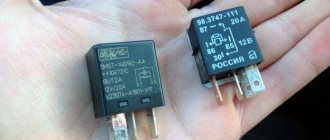Advantages and disadvantages
The electromechanical braking system, equipped with additional functionality in the form of the AutoHold mode, boasts a wide range of advantages. But there are also some disadvantages that you should be aware of.
Do not press the brake pedal
Let's start with the positive qualities. These include the following points:
- The hold system reduces the load on the driver, who has to work less on the brake pedal. This is especially noticeable when the car is constantly used in urban environments, where there is a problem of traffic jams, constant traffic lights and the need to frequently stop, accelerate and brake again. In fact, autohold eliminates the need to constantly depress the brake pedal and keep it in that position;
- Automatic hold is very helpful when stopping and starting on sections of the road with inclines. The additional functionality of the electromechanical braking system prevents rolling back and forth;
- Due to the control unit, the system automatically holds the car in place. In this case, it does not matter for what reason the vehicle stopped;
- Additional security. This manifests itself in the form of implemented mandatory conditions for enabling the hold mode. After all, this only happens when the driver’s door is opened, the seat belt is unfastened and the engine is turned off;
- Simple and convenient inclusion. The button is usually located in an accessible area;
- An excellent alternative to a large, massive and not always convenient standard handbrake;
- The electric brake does not require adjustment during normal operation;
- The auto hold is released automatically, thereby eliminating situations where the driver forgot to release the handbrake.
But in order to objectively evaluate the automatic hold system, it is worth looking at the other side of this mode.
In general, car enthusiasts identify 3 main disadvantages in electromechanical brakes with AutoHold.
- The driver cannot independently control the degree of brake force. This is one of the problems with an electromechanical brake that is missing in a standard mechanical handbrake.
- If the battery is completely discharged, the driver will not be able to release the car from the handbrake mode. First, you will have to replenish the battery charge, and only then will you be able to turn off the system.
- Price. The presence of an electromechanical brake in combination with automatic holding affects the price of the car. The car becomes more expensive. And not only in terms of purchase, but also in terms of maintenance and repair. If the system fails, repairing it will be noticeably more expensive than restoring the functionality of a conventional handbrake.
Whether to buy such a car or not, each motorist must decide for himself. Despite some disadvantages, which become conditional if you follow the basic rules of operating a car, AutoHold and the entire electromechanical brake system have more significant advantages than weaknesses. Therefore, gradually more and more cars are gaining such capabilities, and automakers are abandoning the classic mechanical hand brake with cables and a control lever.
Technical features and purpose of the HOLD button on an automatic transmission
Having bought a car with an automatic transmission, novice car enthusiasts notice the HOLD button, but not everyone is in a hurry to try the special operating mode of the automatic transmission. This mode itself represents the start of movement not from first, but immediately from second gear. This helps to avoid slipping when starting on slippery surfaces. It would seem to be very functional in some situations, especially in cold seasons, but nevertheless, the use of this button causes controversy among drivers.
If we literally translate HOLD from English, we get “fixation”, “holding”. This function, as it were, limits the range of speeds, limiting the inclusion of higher or lower ones. You can see the button designations in the form of a snowflake and an asterisk.
This button has its own nuances. It is almost always located near the automatic transmission, but can be found on the dashboard of some brands and certain models of cars. When you press on the dashboard, the speedometer lights up the corresponding inscription. It is also worth mentioning that using the HOLD button increases gas mileage, so it is recommended to disable this function during normal driving. Despite the gas consumption, the function has quite a few advantages.
It will help provide assistance in situations such as:
- downward movement. When you press this button, the car will slow down and will not be able to accelerate.
- overtaking another car, because at a sufficiently high speed, that is, in fourth gear, the engine speed increases sharply when HOLD is turned on and traction increases.
- cold seasons and slippery roads. In this case, it is recommended to keep the HOLD button turned on at all times.
- traffic jams. If you start straight from second gear, it reduces the number of jerks in heavy traffic.
- climbing up a slippery road.
It is also necessary to take into account that turning on the HOLD button slows down the car and prevents it from accelerating to high speeds. Here, each car already has its own limitations. Therefore, using this button on the highway (except in winter) does not make sense and only hinders your, as well as the general movement.
Types of automatic transmission
Car owners traditionally call the entire transmission of a car a gearbox.
From a technical point of view, the gearbox is considered to be only that part of the unit in which a number of planetary gears are located that ensure gear shifting. An automatic transmission can be considered any device that changes gears without driver intervention, but traditionally the name “automatic transmission” has been assigned to a hydromechanical design. Conventionally, automatic transmissions also include a variator and a robotic gearbox.
Traditional automatic transmission
A traditional automatic transmission includes: a torque converter, a manual gearbox and a control system. And it is, in fact, a hydromechanical transmission. The torque converter in the automatic transmission acts as a clutch, i.e. it provides smooth supply and adjustment of torque from the engine to the gearbox. All its parts are enclosed in a housing in which they are in a special oil fluid - ATF.
When the engine starts, the crankshaft begins to rotate, and the movement of the torque converter pump wheel starts. It moves the ATF working fluid to the turbine wheel, which begins to rotate and transmits torque to the planetary gearboxes. The torque converter develops maximum torque at minimum speed.
As the speed increases further, the rotation of the pump and turbine wheels are aligned, the torque converter is locked, and torque is transferred directly from the engine to the manual transmission. Thus, when you press the gas pedal and increase the speed and vice versa, the gears are switched automatically.
Type-tronic
The type-tronic design is a type of automatic transmission that has a manual control mode. The driver can select gears manually while driving by moving the lever in the "+" and "-" directions. The structure of such a box is not fundamentally different from the traditional one; only the automatic control and gear shift lever are changed.
Driving a car with a type-tronic gearbox can be performed in two modes: full automatic and manual control. Manual mode imitates the control of a manual transmission in a sports car, but does not require the same serious skills and qualifications from the driver as from professional athletes in auto racing mode.
Robotic box
This transmission can be conditionally classified as automatic, since, in fact, it is a manual gearbox, but with electronic control. Gear shifting and clutch engagement are controlled automatically. The driver and driving conditions provide the input of information, and the operation of the box itself is started by an electronic unit, which contains a specific control algorithm.
The electronic control system includes sensors that receive information about rotation speed, selector lever position, oil level and pressure. They transmit information to the control unit, which analyzes them and selects the appropriate operating algorithm.
The robotic box can operate in two modes: full automatic and semi-automatic. Semi-automatic mode allows the driver to manually select the mode using a lever. This function is similar to the type-tronic in an automatic transmission. In some sources, the robotic gearbox is called a sequential gearbox.
Variable speed drive
The CVT transmission has the generally accepted abbreviation CVT, which in its full form means “continuously variable transmission”. The variator does not have fixed gears and switching between them. During operation, the variator constantly smoothly changes the gear ratio as the vehicle speed changes, so this design very conventionally applies to gearboxes.
The design of a CVT transmission consists of two pulleys and a V-belt stretched between them. The pulleys consist of two cones, the narrow part facing each other. The change in gear ratio occurs due to the smooth sliding of the belt along a smaller or larger radius of the pulley, so when moving, the torque changes continuously and there are no jerks.
The CVT provides comfortable driving, maximum efficiency in using engine power and fuel economy. However, due to the high complexity of the design, repairing the CVT box is very expensive.
System operation in dynamic auto mode
Depending on the manufacturer, the conditions for activating automatic hold may vary, but the basic set is usually standard:
- The driver's side door is closed;
- seat belt fastened;
- the motor is running;
- auto hold button is pressed.
The last action is responsible for transitioning the function to the waiting and ready state. Thanks to its intelligent mind, the system will turn on and begin to act as soon as the need arises.
In most modern cars, the system operates in constant mode from the moment it is turned on. In some models, after turning off the engine, a second action may be required, that is, you need to press the button again, observing the conditions described above.
Driving downhill is safer with AUTO H mode in operation.
Why is there a hold button in a multimeter and what is it for?
Starting the engine with a button: diagram and features of self-installation
The Data hold button, which the multimeter has, is considered useless by some, while others, on the contrary, use it often. It means data retention. If you press the hold button, the data displayed on the display will be fixed and will be displayed continuously. When pressed again, the multimeter will return to operating mode.
This function can be useful when, for example, you have a situation where you alternately use two devices. You have carried out some kind of standard measurement, displayed it on the screen, and continue to measure with another device, constantly checking with the standard. This button is not available on all models; it is intended for convenience.
Measuring direct and alternating current with a multimeter is also its main function, as is measuring resistance. You can often find the following designations on the device: V and V
- constant and alternating voltage, respectively. On some devices, constant voltage is designated DCV, and alternating voltage ACV.
Again, it is more convenient to measure current in automatic mode, when the device itself determines how many volts, but this function is available in more expensive models. In simple models, direct and alternating voltage during measurements must be measured with a switch depending on the range being measured. Read about this in detail below.
Purpose and functions of an electromechanical brake
In the classic design, the parking brake is made in the form of a mechanical unit, equipped with a cable system and a control lever. But gradually they began to abandon this scheme.
Disc brake operation
Automakers are increasingly installing electromechanical parking brakes equipped with the AutoHold function on their cars. The electromechanical brake itself is most often labeled as EPB in technical literature and car documentation. It performs several functions simultaneously:
- Fixes the vehicle when the car is parked;
- Prevents accidental and spontaneous movement of the car;
- Prevents the car from rolling backwards when you have to start from a slope;
- Performs the function of an emergency brake in case of failure of the main braking system.
The confusion that arises does not immediately make it clear what AutoHold is in a car and what the button labeled as AutoHold actually means.
If you delve into the essence, it will immediately become clear what AutoHold actually means. After all, this is an interior button for activating an additional mode of operation of the electromechanical parking brake on cars where this version of the handbrake is used. And the activator is displayed in the form of a button on the panel near the automatic transmission, that is, in the selector area. Most often, the button is located on the driver’s side for more convenient and quick access.
Depending on the car and the car manufacturer, different designations may be used. But mainly this is a button directly with the name AutoHold, or an icon of the classic designation of a handbrake, inside which the letter A is written.
In order to better understand and understand what AutoHold is on a modern car, you should study in more detail the principle of operation of this mode or function.
Principle of operation
It is already clear that AutoHold is an additional function of an electromechanical parking brake. The translation of the name also partially helps to understand the essence, because AH can be translated as automatic hold.
Modern cars have recently begun to be equipped with the automatic hold function. To activate this mode, just press the corresponding button near the automatic transmission selector. In fact, this is expanded functionality or additional logic in the operation of an electromechanical brake. The brake pads continue to act on the braking discs even when the driver has already taken his foot off the brake pedal.
Currently, additional functionality in the form of an AutoHold button in the car interior near the automatic transmission works as standard on many cars from Volkswagen, BMW, Kia, etc. The button is installed in basic configurations, but in some cases it is available in more expensive versions.
To understand exactly how this button labeled AutoHold works, you need to know some nuances. To begin with, it is important to note that the system is based on the performance of an impressive number of sensors during operation. The automatic hold system collects information about:
- the slope and angle of inclination at which the vehicle is currently located;
- current position of the gear selector;
- position of the clutch pedal if the gearbox is mechanical;
- the speed at which the driver lowers the pedal;
- the current speed of the car if the car is moving.
All this is necessary for the system to clearly understand when to turn on and off the braking.
Brake system assembly
As a result, the operating principle of the automatic hold system, implemented in the form of the AutoHold button, can be described as follows:
- First, the driver presses the pedal intended to brake the vehicle;
- Then presses the corresponding automatic hold button, that is, AutoHold;
- When pressed, the control electronic unit activates the system, which is put into standby mode;
- After the vehicle has come to a complete stop, the holding system switches to the active operating mode;
- Even if the driver takes his foot off the brake pedal, the car will remain motionless. This is facilitated by the active operation of the AutoHold system;
- AutoHold will keep the car stationary until the driver turns it off himself, or activates the main parking brake, that is, EPB.
When the driver removes his foot from the brake pedal, but thereby stops giving the command to fix the wheels using the brake system. But at the same time, the necessary pressure in the line will still be maintained.
Advantages and disadvantages
The electromechanical braking system, equipped with additional functionality in the form of the AutoHold mode, boasts a wide range of advantages. But there are also some disadvantages that you should be aware of.
Do not press the brake pedal
Let's start with the positive qualities. These include the following points:
- The hold system reduces the load on the driver, who has to work less on the brake pedal. This is especially noticeable when the car is constantly used in urban environments, where there is a problem of traffic jams, constant traffic lights and the need to frequently stop, accelerate and brake again. In fact, autohold eliminates the need to constantly depress the brake pedal and keep it in that position;
- Automatic hold is very helpful when stopping and starting on sections of the road with inclines. The additional functionality of the electromechanical braking system prevents rolling back and forth;
- Due to the control unit, the system automatically holds the car in place. In this case, it does not matter for what reason the vehicle stopped;
- Additional security. This manifests itself in the form of implemented mandatory conditions for enabling the hold mode. After all, this only happens when the driver’s door is opened, the seat belt is unfastened and the engine is turned off;
- Simple and convenient inclusion. The button is usually located in an accessible area;
- An excellent alternative to a large, massive and not always convenient standard handbrake;
- The electric brake does not require adjustment during normal operation;
- The auto hold is released automatically, thereby eliminating situations where the driver forgot to release the handbrake.
But in order to objectively evaluate the automatic hold system, it is worth looking at the other side of this mode.
In general, car enthusiasts identify 3 main disadvantages in electromechanical brakes with AutoHold.
- The driver cannot independently control the degree of brake force. This is one of the problems with an electromechanical brake that is missing in a standard mechanical handbrake.
- If the battery is completely discharged, the driver will not be able to release the car from the handbrake mode. First, you will have to replenish the battery charge, and only then will you be able to turn off the system.
- Price. The presence of an electromechanical brake in combination with automatic holding affects the price of the car. The car becomes more expensive. And not only in terms of purchase, but also in terms of maintenance and repair. If the system fails, repairing it will be noticeably more expensive than restoring the functionality of a conventional handbrake.
Whether to buy such a car or not, each motorist must decide for himself. Despite some disadvantages, which become conditional if you follow the basic rules of operating a car, AutoHold and the entire electromechanical brake system have more significant advantages than weaknesses. Therefore, gradually more and more cars are gaining such capabilities, and automakers are abandoning the classic mechanical hand brake with cables and a control lever.
Auto Hold Brake Functions
The electromechanical car brake in the instructions for foreign cars is often designated as EPB. The abbreviation is revealed as Electromechanical Parking Brake. Its functions:
- securing the car when parking;
- preventing rollback when stationary, as well as when starting from a slope;
- emergency braking if the main braking system does not work for some reason.
Vehicles equipped with an electromechanical brake are equipped with an interior button for activating it, designated as Auto Hold. An example of such a button:
Sometimes there is another image - a handbrake icon with the letter A inscribed in it:
Auto Hold. What is this button and how to use it. Principle of operation
The parking brake is an important and necessary structural element of a car. With its help, the car is fixed in place during parking, and the spontaneous rollback of the vehicle is also prevented. The classic layout of the parking brake is mechanical, with a cable system and a control lever, but in modern cars the use of an electromechanical unit with the auto hold function is becoming more frequent. Parking brake with auto hold - what is it and how does it work?
Auto Hold Brake Functions
The electromechanical car brake in the instructions for foreign cars is often designated as EPB. The abbreviation is revealed as Electromechanical Parking Brake. Its functions:
When is it necessary to adjust the parking brake drive?
The parking brake in a car performs two important functions. It not only holds the car motionless during parking and stopping, but also duplicates the hydraulic braking system. According to current regulations, all vehicles are required to be equipped with a backup braking mechanism, which will allow the vehicle to be stopped if the main system fails.
Many domestic motorists do not use the parking brake (or use it extremely rarely). While parking, they leave the car in gear (manual transmission) or set the automatic transmission shift lever to the “parking” position. There is a misconception that in this way they protect the handbrake from accelerated wear.
At the same time, any mechanisms retain their performance better with constant use. If a mechanically or electrically controlled parking brake rarely works, then the first element that fails is the cable. This malfunction reduces the effectiveness of the entire rear wheel braking mechanism.
Using the parking brake is necessary to ensure the safety of the vehicle while parking. Owners of cars with automatic transmission have probably heard an unpleasant grinding noise and felt a slight jolt of the car if they try to put the gear shift lever in the “Parking” position without waiting for the car to come to a complete stop. This is how the transmission locking system works. It cannot guarantee that the vehicle will be held while parked under high loads.
If we consider a car with a “mechanics”, it is worth noting that when the gear is engaged while parked, a rigid connection is formed between the idle engine and the drive wheels. Under strong impacts (for example, when a heavy car is parked on a slope), the rotation of the wheels leads to the rotation of the engine elements. This situation can cause expensive repairs to the timing belt or engine.
Under some circumstances, on the contrary, it is not recommended to tighten the handbrake while parking the car. In winter, after washing or during snow and rain, moisture that gets into the handbrake drive mechanism freezes and jams it.
Factors contributing to the loss of parking brake functionality include destruction of the cable sheath. As a result of dirt, dust and moisture getting under the sheath, as well as under the influence of corrosion, the handbrake cable turns sour and loses the ability to move inside the sheath, but moves with it. Loss of cable mobility can also occur as a result of melting of the sheath, since the parking brake drive is located close to the exhaust system. In all the cases described here, car repair specialists recommend replacing the handbrake cable along with the sheath.
Another common malfunction of the parking brake drive is excessive stretching of the cable. In this case, it will not be possible to make normal adjustments to the handbrake, so it will not be able to keep the car stationary. In addition, too stretched cables interfere with the correct operation of the rear brake mechanisms. After replacing the handbrake drive, its tension must be adjusted.
Shift Lock button on an automatic transmission: what is it for?
How to adjust the parking brake?
Let's start with the fact that an automatic automatic transmission is much more complex than the usual and relatively simple manual transmission. Today, automatic transmissions are equipped with complex electronic control units and have many different operating modes in relation to certain conditions.
At the same time, the boxes and ECUs themselves are being improved all the time; more and more electronic components are being included in the automatic transmission device, which replace outdated mechanical solutions. However, there are also disadvantages to using electronics.
Various microcircuits, sensors and board components, wiring and other parts often fail under the influence of vibrations, moisture, etc. Also, other mechanical failures cannot be ruled out.
Let's move on. As is known, an automatic transmission, in addition to the main PRND modes, often has the ability to block upshifts (for example, modes L2 or 1, when the automatic transmission does not go above second speed or only works in first gear).
Let us immediately note that while the purpose of the various buttons responsible for certain operating modes of the automatic transmission is more or less clear on an intuitive level, with the Shift lock release button everything is not so simple. The fact is that after pressing it, nothing changes in the operation of the box, that is, the driver does not notice any changes.
To understand its purpose, it should first be noted once again that the automatic transmission is a complex unit. Modern versions have a large number of not only mechanical and hydraulic, but also electronic components in their device.
To put it simply, gear shifting on an automatic transmission is implemented using complex circuits. There are also various methods of protection against accidental gear shifting while driving, against starting the engine with the gear engaged, etc.
In a nutshell, in this mode, a small steel pin locks the shaft inside the box, which allows you to lock the drive wheels (like a handbrake) and prevent the car from spontaneously rolling back. Also, the automatic transmission selector is locked (there is no way to move it) until the driver presses the brake pedal and inserts the key into the ignition.
Let's go back to the shift lock. As a rule, the Shift Lock button on an automatic transmission is located closer to the lever (usually next to the P mode). Moreover, if you press the indicated button, nothing will be displayed on the instrument panel, no changes in the operation of the automatic transmission will occur, the engine speed does not change, all gears are engaged and operate in normal mode, etc. It is also noteworthy that the button does not have a light indication and does not lock in the on or off position.
So, please note that the “shift lock” button of the automatic transmission is not any mode of operation of the gearbox. This button actually allows you to forcibly remove the lock in the “parking” mode and move the gearbox selector to the desired position if the car engine is turned off.
In other words, drivers of cars with automatic transmission are well aware that in mode P, the shaft locking inside the box, which was mentioned above, is activated. In this case, it is impossible to move the selector lever without pressing the brake pedal or inserting the key into the ignition switch (the algorithm may differ for different cars).
In practice, if the engine does not start, and the automatic transmission lever cannot be moved from “P” to another position (for example, to neutral N to push the car), it is the “shift lock” that allows you to unlock the automatic transmission.
To make the lever movable, you need to press this button, after which, while holding the shift lock pressed, you can move the selector. This is often necessary in situations where the engine does not start and the car needs to be towed without hanging the drive wheels.
Let’s also add that on some automatic transmissions, especially old ones, instead of a shift lock button you can find a key hole next to the selector lever. So, this hole is actually an analogue of a button.
In order to be able to move the box selector, you need to insert the key with which the driver starts the car into the specified lock. This will unlock the lever, after which it can be switched to N mode from P mode.
Dynamic auto braking function
If the brake pedal fails or becomes blocked, the vehicle can be effectively braked using the dynamic emergency braking function.
Pull and hold the parking brake button and the car will brake at a deceleration rate of about 6 m/s (which is about 60% of maximum braking).
At this time, an audible warning signal sounds and the brake lights turn on.
The emergency braking function is implemented when the vehicle speed is over 7 km/h by increasing the hydraulic pressure in the brake system. The braking process, if necessary, is supported by the ABS/ESP function. Thanks to this, the vehicle's stability is maintained during braking.
When the button is released at a speed above 7 km/h or when the accelerator pedal is pressed, the emergency braking function is deactivated. After stopping the vehicle, the parking brake must be released as described for parking.
At speeds below 7 km/h, the parking brake operates in standard electromechanical mode.
Module design
General structure
An electromechanical brake is usually installed on the rear axle. It includes:
- brake mechanism;
- brake drive;
- and control system.
The standard brake mechanism for a particular vehicle is used. Some design modifications are made to the working cylinders, and an electromechanical drive is mounted on the caliper.
The wheel mechanism of the electromechanical parking brake can be depicted schematically as follows:
Number 1 indicates the piston, 2 indicates the electric motor, number 3 in the figure shows the drive belt, and 4 indicates the gearbox.
Gearbox device:
Designations:
- number 1 – driven gear of the unit;
- number 2 – output shaft of the device;
- number 3 – indicates the pulley hub;
- number 4 – the pulley itself;
- number 5 – schematic representation of the gearing of the teeth of the swinging and driven gears.
The oscillating gear is an important design element. It is mounted on the hub at a certain angle. This provides it with the ability to swing, and the gear is protected from complete rotation in relation to the body by two special leads. When movement occurs, two teeth of this gear mesh with the driven one, and due to the difference in the number of teeth, the engagement is not complete. A revolution of the pulley moves the driven gear by only one tooth.
A toothed belt drive connects the motor to the gearbox. The latter repeatedly reduces the speed at which the output shaft rotates, which allows the system to develop the necessary force for the brake to function.
The next important element is a piston with a special screw pair, consisting of the brake cylinder piston itself (1), a pressure nut (2) and a spindle (3):
The rotation of the driven gear is converted into a translational stroke of the rod due to the screw pair. The rod puts pressure on the piston, which moves the pads towards the wheel. The pressure force created is determined by the ECU of the electromechanical automobile brake, which is guided by the readings of the value of the electric current consumed by the system. The drive motor will turn off when the current reaches the programmed value.
If the car is removed from the previously set “handbrake”, the motor will rotate in the opposite direction and retract the rod, removing the braking force.
Electronic parking brake is installed on cars:
Golf hatchback, Golf Sportsvan, Golf Variant, Sharan, Touareg, Tiguan, Touran, Passat sedan, Passat Variant, Volkswagen CC.
The advantages of an electromechanical parking brake over a conventional one are obvious. Instead of a bulky lever between the front seats, there is a compact button. There is no need to drag cables and rods across the entire bottom - just connect the control unit to a common electrical bus and equip the brake mechanisms on the rear wheels with electric motors. In other words, this design simplifies layout and assembly, reducing production time and costs.
In addition, during operation there is no need for adjustments - the electronics monitor the gap between the pads and the disc whenever the parking brake is applied. And if it is rarely used (for example, on cars with automatic transmissions), then the system tightens the handbrake every 1000 km.
The operating algorithm is similar for most cars. The driver presses a button from which a signal is sent to the parking brake control unit.
Wheel parking brake mechanism:
2 - electric motor;
3 - drive belt;
4 - gearbox with a swinging washer.
The electric motor is connected through a toothed belt drive to a gearbox, which reduces the rotation speed of the output shaft by tens of times and makes it possible to develop the force necessary for the operation of the braking mechanisms.
If the car is stationary or moving slower than 7–10 km/h, the electric motors turn on, activating the brakes. At higher speeds, the ABS unit turns on the hydraulic pump - the pressure in the brake circuits increases. The car slows down and then puts the handbrake on.
Oscillating gear reducer:
1 - driven gear;
2 - output shaft;
3 - toothed pulley hub;
4 - toothed pulley;
5 - meshed teeth of the swinging and driven gears.
One of the main parts of the gearbox is the swing gear. It is mounted on the hub of the drive pulley at an angle and therefore swings when rotating. It is kept from rotating relative to the gearbox housing by two leads sliding along the inner walls of the gearbox housing. During movement, only a pair of teeth on the oscillating gear are constantly in mesh with the teeth on the driven gear. Moreover, the swinging gear has one tooth more than the driven gear, so there is no full engagement. Only one tooth of the swinging gear with its side surface presses on the mating part of the driven gear, turning the latter at a small angle. As a result, for a full revolution of the toothed pulley, the driven gear moves only one tooth.
The driver can “tighten” the electromechanical parking brake even with the engine turned off, but release it only by turning on the ignition and pressing the brake pedal.
If the engine is running, the driver has closed the door and buckled up, the handbrake will turn off automatically when the accelerator is pressed. At the same time, the body roll sensor recognizes whether the car is on an incline, takes into account the position of the clutch and accelerator pedals and holds the brakes to prevent the car from rolling back.
Piston with screw pair:
1 — brake cylinder piston;
2 - pressure nut;
3 - spindle.
The screw pair converts the rotation of the driven gear into translational movement of the rod. He presses on the brake piston, bringing the pads to the disc. The force is controlled by the parking brake control unit based on the amount of current consumed. As soon as the value reaches the required value, the electric motor will turn off. When removed from the handbrake, the motor rotates in the opposite direction, the rod moves back, and the piston moves due to the elasticity of the sealing collar.
Often next to the electric handbrake button there is another one that turns on the Auto Hold function. It makes life much easier. For example, when pushing in traffic jams in a car with an automatic transmission, you don’t need to keep your foot on the brake. The car has stopped, the driver releases the pedal, but the valves of the ABS unit remain closed - the pressure in the circuits is high, the pads compress the brake discs. If the stop lasts more than a couple of minutes, the ABS will take over the parking brake.
The car will engage the handbrake even earlier - if, for example, the driver unfastens the seat belt, opens the door or turns off the ignition.
Electric parking brake: No longer manual
Electrics are replacing mechanics everywhere. Even the parking brake cable was replaced with wires. A short lecture on how the new generation handbrake is designed and works is given by Gennady Emelkin.
The advantages of an electromechanical parking brake over a conventional one are obvious. Instead of a bulky lever between the front seats, there is a compact button. There is no need to drag cables and rods across the entire bottom - just connect the control unit to a common electrical bus and equip the brake mechanisms on the rear wheels with electric motors. In other words, this design simplifies layout and assembly, reducing production time and costs. In addition, during operation, there is no need for adjustments - the electronics monitor the gap between the pads and the disc whenever the parking brake is applied. And if it is rarely used (for example, on cars with automatic transmissions), then the system tightens the handbrake every 1000 km.
The operating algorithm is similar for most cars. The driver presses a button from which a signal is sent to the parking brake control unit. If the car is stationary or moving slower than 7–10 km/h, the electric motors turn on, activating the brakes. At higher speeds, the ABS unit turns on the hydraulic pump - the pressure in the brake circuits increases. The car slows down and then puts the handbrake on.
The driver can “tighten” the electromechanical parking brake even with the engine turned off, but release it only by turning on the ignition and pressing the brake pedal. If the engine is running, the driver has closed the door and buckled up, the handbrake will turn off automatically when the accelerator is pressed. At the same time, the body roll sensor recognizes whether the car is on an incline, takes into account the position of the clutch and accelerator pedals and holds the brakes to prevent the car from rolling back.
Often next to the electric handbrake button there is another one that turns on the Auto Hold function. It makes life much easier. For example, when pushing in traffic jams in a car with an automatic transmission, you don’t need to keep your foot on the brake. The car has stopped, the driver releases the pedal, but the valves of the ABS unit remain closed - the pressure in the circuits is high, the pads compress the brake discs. If the stop lasts more than a couple of minutes, the ABS will take over the parking brake. The car will engage the handbrake even earlier - if, for example, the driver unfastens the seat belt, opens the door or turns off the ignition.
The parking brake is an important and necessary structural element of a car. With its help, the car is fixed in place during parking, and the spontaneous rollback of the vehicle is also prevented. The classic layout of the parking brake is mechanical, with a cable system and a control lever, but in modern cars the use of an electromechanical unit with the auto hold function is becoming more frequent. Parking brake with auto hold - what is it and how does it work?
Auto Hold
Some car models are equipped with an automatic hold function, activated by pressing the Auto Hold key. This is an extension of the logic of the electromechanical brake: the brake pads continue to compress the discs even after the brake pedal is released.
Operating principle
The Auto Hold function has become standard for a number of cars from the Volkswagen concern (VWTouareg, VW Tiguan, VW Passat, VW Golf families), the Korean company KIA, BMW, and some others. In its work, this system relies on the readings of many sensors:
- slope analyzer on which the vehicle is located:
- accelerator and (for manual transmissions) clutch pedal positions;
- pedal release speed estimates;
- estimates the speed of the car if the vehicle is moving.
All this is necessary for timely activation and release of the brake.
In general, the system works like this:
- The driver depresses the brake and presses the Auto Hold mode button. The ECU activates the system and enters the standby state;
- when the car comes to a complete stop, the system goes into active mode, and even when the brake pedal is released, the vehicle remains motionless;
- If the car owner turns on EPB, the Auto Hold module will go into a standby state.
In Volkswagen cars, AutoHold has several subfunctions:
- standing start assistant;
- traffic assistant in Stop-n-Go mode;
- auto-activation of the electromechanical brake.
Having removed his foot from the brake pedal, the driver no longer gives the command to lock the wheels with the brakes, but the pressure in the line continues to be maintained. If the ABS detects driving on a slope (reading the incline sensors, roll sensors, etc.), the brake ECU commands the brake pressure to increase until a stop occurs. Then, when the driver engages the clutch (for a manual) or adds gas (for an automatic), Auto Hold will remove the braking force.
In parking mode, the system switches from hydraulic brakes to the electromechanical part 3 minutes after the vehicle begins to hold, when the seat belt is unfastened, the engine ignition is turned off, or the doors are opened.
Other models may have other distinctive features of this mode.
Auto Hold is turned off by pressing the corresponding button again.
How does an electromechanical parking brake work?
What do the buttons on the automatic transmission shift lever mean: o/d, manu and power?
Activation and deactivation of EMST occurs as follows. When the driver presses the button, the signal from it goes to the ECU, which analyzes a number of parameters and then sends a command to the electric drives, which lock the wheels. Deactivation occurs either automatically, after the driver has started the engine, engaged the gear and is about to start driving, or manually by pressing a button. The EPB is turned off after the control unit analyzes many factors, such as the angle of the body, the position of the gas (or clutch) pedal, the position of the selector, etc. The electric handbrake is turned off with a slight delay, especially in early EPB models, since all factors are analyzed and ECU conditions required a certain amount of time.
In most cases, the electronic handbrake system is supplemented with the Auto Hold option; this option, translated into “human” language, sounds like an automatic hold system during short stops. This system is a kind of extension or addition to the electromechanical parking brake system. Its job is to free the driver from holding the brake pedal after stopping the car. This option is very convenient for cars with automatic transmission when driving in city traffic, which tires drivers with frequent stops while pressing the gas/brake pedals. The electronic handbrake is activated automatically after the car has been parked for a long time. EPB is also automatically activated when the ignition is turned off, a door is opened and the seat belt is pulled out.
Recommendations for use
Brake system components
If you want EPBs with the AutoHold function to serve for a long time and trouble-free, without causing any problems or costly malfunctions, you need to follow a few simple rules.
- If you need to move while auto hold is active, you must press the accelerator pedal. Just do it very carefully and as smoothly as possible. There is no need to twitch and sharply increase engine speed;
- When you are driving downhill, shifting into reverse gear or parking, it is better to turn off AutoHold mode;
- If you notice that the system is not working correctly or does not turn on, you should immediately go to a service center for diagnostics. You should not try to fix the problem yourself;
- Don't overuse auto-hold mode when it's not needed. Also try not to leave the car with AutoHold active for a long time. The mode consumes battery power. And if the battery runs out completely, it will be difficult to remove the handbrake;
- Trust exclusively highly qualified specialists who have all the necessary equipment to work with such systems;
- If service work is carried out, do not forget to switch the electronics to the appropriate service mode.
Electromechanical systems, complemented by the AutoHold function, are a modern solution for vehicles. Manufacturers are increasingly switching to these types of parking brakes, abandoning the classic handbrake with a mechanical drive and a control lever.
There are strengths and weaknesses here. But objectively, the advantages outweigh the conventional disadvantages in many ways. Especially if the system is used correctly and the basic conditions of use are observed.
Operating principle of automatic transmission
Several types of automatic transmissions with their own characteristic features are installed on vehicles.
In a simplified way, the mechanism of operation of a classic automatic transmission consists of transmitting torque from the engine crankshaft to transmission devices, while the gear ratio varies in accordance with the position of the selector lever and the driving conditions of the vehicle.
When the engine starts, working fluid enters the hydraulic transformer and the pressure increases. The blades of the centrifugal pump begin to move, the reactor wheel and the main turbine are motionless in this mode.
When you switch the selector lever and supply fuel using the accelerator pedal, the pump blades increase speed. The increasing speed of the vortex flows begins to rotate the turbine blades. The oil vortices either spread to the stationary reactor or return back to the turbine, increasing its efficiency. The torque is transferred to the wheels, and the car begins to move.
Upon reaching the required speed, the pump wheel and the bladed central turbine move at the same speed, while the vortices of the transmission fluid enter the reactor wheel from the opposite side (movement is possible only in one direction) and it begins to rotate. The unit switches to the hydraulic coupling state.
If the resistance to the wheels increases (uphill movement), the reactor wheel stops rotation and adds torque to the centrifugal pump. When the required speed and torque are reached, the gear in the planetary unit changes.
The electronic control unit transmits a command, as a result of which the braking band and friction discs slow down the downshift, and the increased movement of fluid flows through the valve accelerates the upshift and ensures gear changes without reducing power.
When the machine stops completely or the speed decreases, the pressure of the working fluid decreases and the gear decreases.
When the engine is stopped, there is no pressure in the torque converter, so starting the car with a push is impossible.
Article on the topic: Key synchronization methods
Precautionary measures
If you plan to move off with an active automatic hold (press the gas pedal), you need to depress the pedal carefully, gradually increasing the speed so that the start is smooth, without jerking. It is also advisable to disable this mode when driving downhill, when moving backwards and when parking.
If a malfunction is detected or the system is not operating properly, you should contact an authorized service center to have the complex electronic unit properly diagnosed and repaired.
A vehicle equipped with this system should not be left with the parking brake applied for too long. The unit consumes battery power, and if it is completely depleted, the car will simply not be removed from the handbrake.
When service and repair work is carried out, the machine’s electronics must be switched to service mode. If this is not done, the brake may operate during work, which in turn will lead to damage to the vehicle and injury to people. All service operations, including replacing pads, should be carried out using equipment specially designed for this purpose.
Novice car enthusiasts, not understanding the purpose of the HOLD button, prefer not to turn on the special “automatic” operating mode. Many drivers interpret the nuances of using the button's capabilities in their own way, causing controversy on automobile forums.
Working conditions
“Auto Hold” is activated if several conditions are met (may differ for different car models of a particular manufacturer):
- the driver's door is closed;
- seat belt fastened;
- the vehicle engine is started;
- The Auto Hold function key on the panel is pressed.
The electric parking brake is activated when:
- the function is enabled from the key;
- engine ignition is turned off;
- the driver's side door is open;
- belt unfastened.
A number of makes and models of cars require autohold to be re-engaged after restarting the engine. In other situations, the function works all the time until the engine starts, for example, in the VW Golf 2.
To hold a car standing on a slope, the system needs to create high pressure in the brake lines. If the driver wants to move off in this case, the pressure must be overcome to start moving. The control unit releases the brake only when the engine reaches the required power to prevent rolling.
The system does not enter auto hold mode:
- if the driver's seat belt is not fastened and the door on his side is not closed;
- trunk open;
- the hood is open;
- the automatic transmission selector is moved to the Parking position;
- The electromechanical parking brake is active.
The latter turns on automatically when:
- trunk, hood open;
- sensors detected parking on a slope;
- The driver's door is open, the seat belt is not fastened;
- several vehicle movements occurred;
- the machine is stationary from 3 to 10 minutes.
Advantages of Auto Hold brakes and disadvantages of the system
The electromechanical brake system with the optional Auto Hold extension has a number of significant advantages:
the car owner experiences less stress when operating the vehicle
This is especially important in city driving, with traffic jams and frequent acceleration-stop cycles, because you no longer need to constantly keep the brakes depressed; “autohold” helps to stop and start moving on slopes, the car does not roll; control unit support automatically keeps the car in one place, and it makes no difference why the car stopped; the programmed mode for turning on the electric parking brake when the driver's door is opened, the seat belt is unfastened, the engine is turned off, provides additional safety for people; activation is ensured by a convenient button, replacing a bulky and inconvenient lever; the electric brake does not need adjustment during normal operation; the system turns off automatically (the “forgot to remove the handbrake” situation is eliminated). But there are some disadvantages
Among them:
But there are also some disadvantages. Among them:
- it is impossible to control the degree of brake force, which is available with a mechanical handbrake;
- If the battery is completely discharged, it is impossible to remove the car from the electric handbrake until the charge is replenished;
It is impossible not to mention when talking about Auto Hold that such a solution is more expensive, increasing the price of the car. This includes the higher cost of repairing a failed brake unit.
Are there any downsides?
The disadvantages of EPBs are similar to those inherent in all electronic devices. If one element fails, the entire chain automatically stops. In this case, it will also be impossible to control the degree of brake force and you must constantly monitor the battery current. If it is completely discharged, it will not be possible to remove the car from the handbrake until the electricity charge is replenished.
In addition, there is a danger to the valves of the hydraulic unit - they can overheat due to constant operation. However, modern ABS/ESP is well improved, and this point has been analyzed by engineers. But, unfortunately, not on all cars. According to statistics, in 10% of cars that use an electronic brake, the rear pads wear out faster and the control unit is damaged. And its repair is not a budgetary matter at all.
The Auto Hold function simply duplicates the work of the braking system, doing the work instead of a person. A useful thing if you suddenly get distracted by something. There is no need to be afraid that the car will roll down or backward. However, it cannot be installed on vehicle models not equipped with ESP. In any case, you need to test the car through a special stand for the possibility of installing this factory add-on.
Precautionary measures
If you plan to move off with an active automatic hold (press the gas pedal), you need to depress the pedal carefully, gradually increasing the speed so that the start is smooth, without jerking. It is also advisable to disable this mode when driving downhill, when moving backwards and when parking.
If a malfunction is detected or the system is not operating properly, you should contact an authorized service center to have the complex electronic unit properly diagnosed and repaired.
A vehicle equipped with this system should not be left with the parking brake applied for too long. The unit consumes battery power, and if it is completely depleted, the car will simply not be removed from the handbrake.
When service and repair work is carried out, the machine’s electronics must be switched to service mode. If this is not done, the brake may operate during work, which in turn will lead to damage to the vehicle and injury to people. All service operations, including replacing pads, should be carried out using equipment specially designed for this purpose.
Dynamic traction assist
Provides smooth starting of the car without rolling back when the electromechanical brake is on, even on an uphill slope.
This function is available if:
- the driver's door is closed;
- seat belt fastened;
- the engine is running.
The vehicle should not be held down by the brake pedal (for example, when stopping at a traffic light) if the electromechanical parking brake is activated.
Immediately after pressing the accelerator pedal, the parking brake is automatically released and the vehicle moves off.
If the driver is not wearing a seat belt, the parking brake can only be released manually by simultaneously pressing the brake pedal.
